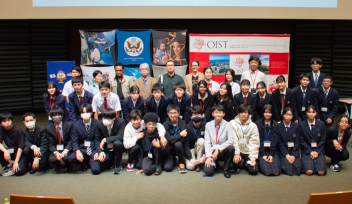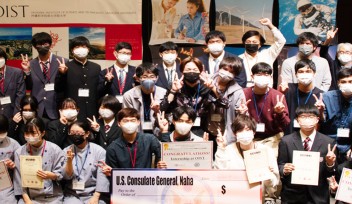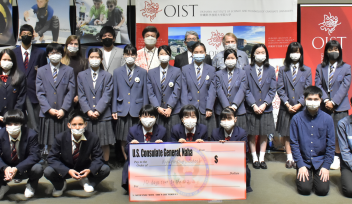What can we do for Okinawa now? High school students compete in science and business ideas

How can you freeze dragon fruit to enjoy the taste for a longer time, and turn the endangered freshwater grass Shimachisujinori (Thorea gaudichaudii), endemic to Okinawa and Kyushu, into an edible plant? Is it possible to build a system that uses cosmic radiation to predict the aging of buildings or AI to predict rip currents? Surprisingly, high school students from Okinawa presented novel solutions to all these questions.
SCience in Okinawa: Research for Enterprise (SCORE!), a competition for high school students in Okinawa Prefecture, was held at the Okinawa Institute of Science and Technology (OIST) on December 16. Entrants present their projects to solve social issues based on science and business in 10 minutes, and compete on the originality of their ideas, presentation skills, entrepreneurial spirit, and scientific thinking ability. Approximately 50 students selected from high schools across Okinawa took part in the 12th annual event.

The presentations were made by seven teams, and they were judged by five judges from inside and outside OIST on scientific thinking, creativity, presentation skills, and English communication skills. The winning team of the competition was from Okinawa Prefectural Chubu Agricultural High School, with the presentation entitled “Development of Frozen Dragon Fruit - Saving Farmers with Freezing Technology”.
Chubu Agricultural High School, located in Uruma City, Okinawa, has been a regular participant in the competition since the first event in 2013, but this year they finally achieved their long-held goal of winning first prize. The team, consisting of the three sophomores, Hibiki Korogi, Sora Ahagon, and Miyu Ishikawa, learned from dragon fruit famers that dragon fruit is difficult to preserve and has a limited season, making it difficult to turn a profit due to price competition. As a solution to this problem, the team took on the challenge of developing a technology for freezing dragon fruit, to preserve it for a longer period. Dragon fruit is usually unsuitable for freezing due to its high water content, but the team sought to develop a freezing technology that would preserve dragon fruit for a longer time while maintaining its delicious taste. The judges selected the team as the winner for their presentation skills, scientific acumen, and practicality.

Ms. Ahagon, who led the team, said with enthusiasm that, “we started this project with the future of agriculture in Okinawa in mind, so we are very happy that our work has been recognized. We were worried about presenting our project in English, but it was worth it because we worked very hard. When freezing dragon fruit, the peeled skin is inevitably discarded, so we would like to continue the project to solve this problem.”
In addition, OIST invited Takashi Hiyane, an entrepreneur who founded IT companies in Okinawa and who is passionate about human resource development and supporting entrepreneurship, to share his valuable experience with the audience. Mr. Hiyane has been working for a better future for Okinawa, to make Okinawa truly affluent. His passion and practical approach have garnered attention for both his entrepreneurial spirit and his contributions to society. The high school students in the audience were drawn into Mr. Hiyane's talk and eagerly asked questions, as it was an opportunity to get inspiration for what kind of attitude and skills are required of the next generation of leaders who will be responsible for the future of Okinawa.

Prize-winning Teams
1st Prize: Okinawa Prefectural Chubu Agricultural High School
“Development of Frozen Dragon Fruit - Saving Farmers with Freezing Technology”
2nd Prize: Okinawa Prefectural Misato High School
“Basic Research on the Development of Cultivation Techniques for the Edible Use of Shimachisujinori (Thorea gaudichaudii)”
3rd Prize: National Institute of Technology, Okinawa College
“Innovative Approaches to Coastal Rip Current Prediction using Spatio-temporal Stream Vectors and Machine Learning”
Poster Presentation 1st Prize: Okinawa Shogaku High School
“Do the Stems of the Getto (Shellflower, Alpinia speciosa) Contain More Antibacterial Properties Than the Leaves?”

More photos from the event are available here.














